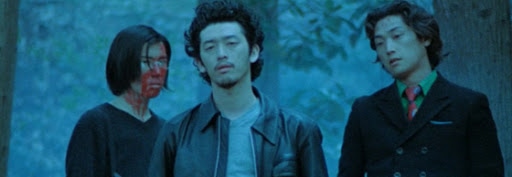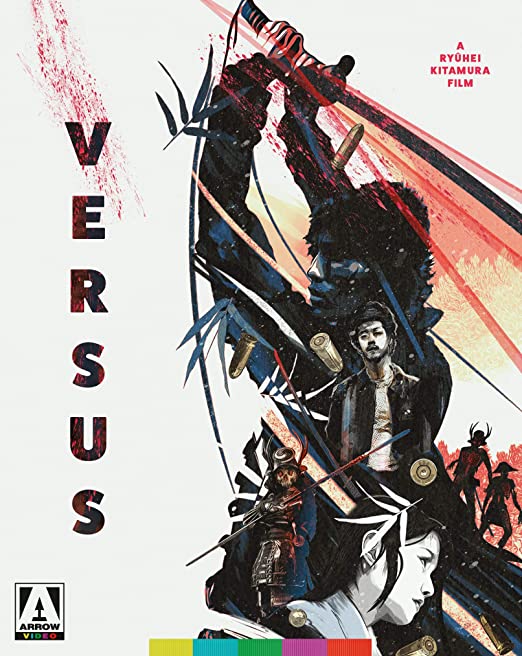Legend has it that 666 portals to the netherworld are scattered throughout our universe. While human beings remain blissfully unaware of these dimensional gateways, the 444th is nestled deep in Japan’s “forest of resurrection.” Strange things happen in this remote forest that unfortunately serves as a preferred dumping ground for Yakuza hits. Versus brings this all to life.
More than just fill people with a queasy kind of anxiety, closeness to the portal also tends to make mortality a little less…… final. When the dead don’t exactly die the first, second, or third time, body counts can verge into the exponential, as indeed it does in Ryuhei Kitamura’s bloody (as in gallons) breakout indie hit.
The 411 on the 444
The Forest of Resurrection is also the stage for the epic centuries-old battle at the heart of Versus. “The man,” as he is credited, is a subdued but staggeringly powerful warrior played by Hideo Sakaki, hellbent (literally) on opening the 444th portal by spilling the blood of the chosen one (Chieko Masaki, credited as “the girl”).
Standing in his way is escaped Prisoner KSC2-303, played by the now legendary actor/fight choreographer Tak Sakaguchi, who is about as flippant and aloof as they come…until he sees a chance to throw down street style.
Prisoner KSC2-303 has no memory of his past lives. Thus, he misunderstands his connection to the events that pit him against a bumbling Yakuza faction, the ageless warrior vying for blood to open his Hellgate, and the woman he is protecting amid a repeatedly resuscitating army of zombie samurai and felled Yakuza.
As unclear as he is about the who/what/where/why of this convergence of forces in the forest of resurrection, his instinct for the fight and his brash confidence in battle are without question. He doesn’t need to dig deep. It is all inborn, and he brings it like a boss, bare-knuckled.
It would be an exaggeration to say that Prisoner KSC2-303 is any kind of altruistic defender of the weak. Director Kitamura paints him as an utterly crass and self-preserving anti-hero with swagger and style to burn. He is eager for conflict, is unfazed in the presence of zombie hordes, has no hesitation in shedding the blood of fools, and is mostly annoyed at the prospect of having to save someone.

Source: Napalm Films 2000. Arrow Films 2020 blu-ray
His disaffected coolness, combined with a staggering skillset with bullets, blades, and braun, make for someone you love to just watch as all the vectors of this ages-old confrontation intersect upon him.
Call a Spade a Spade
It may do better to admit the truth: that Versus is perhaps a work of greatness precisely because it doesn’t fake an intellect (which is not the same as being dumb). But that is only half the equation. With a full-tilt assault on the senses, Kitamura’s concerns in Versus are about movement, action, attitude, texture, and pitch and much less about the story. The intelligence and invention behind Versus are to found in its mechanics and mania.
Kitamura keeps us rapt through a full-throttle shooting and editing style that draws influence from pop culture classics: John Woo’s class act masterpiece, “The Killer “ (1989); Shinya Tsukamoto’s cyberpunk bombshell, “Tetsuo” (1986); and with more than a mere nod to Russell Mulcahy’s, “Highlander” (1986).
Kitamura’s ability to merge these kinds of hyper-cool and hyper animated visual styles with epic stakes and even black comedy makes him a sort of mad cinematic scientist.
This piece of grizzly guerrilla filmmaking, shot on a $10,000 budget in the middle of the woods, emerged as a dark horse of the already pitch black Asian Extreme cinema of the late ’90s and early 2000s.
This “movement” spearheaded (but was not limited to) the now-defunct UK based Palisades Tartan label, packaged reasonably well-budgeted and aggressively moody films from different Asian markets like Japan, South Korea, and China: Films like “Ringu,” “Oldboy,” “Ichi the Killer,” “Suicide Club,” and “The Eye” were all distributed under the “extreme” banner.
These films were easy to commodify for the western audience because they featured exceptionally dark, unrepentantly brutal elements alongside highly refined techniques and potent atmospherics. It made them shocking, artful, and (as problematic as this word is) “exotic” antidotes to the dregs of the turn of the 21st-century arthouse cinema.
No Guts No Glory
Kitamura’s Versus was a wake-up call and a war cry in 2000. It isn’t an ironic film. It doesn’t mince words or parse deeper meanings. It was and is a sincere straight-up middle finger to the film world. Versus was nothing if not the announcement of a new talent that gave zero you-know-what's about anything other than making uncompromising balls-to-the-wall trash art and having a blast while doing it.
That counter-culture approach would, as it sometimes does, ironically pave Kitamura’s way into mainstream projects like Godzilla: Final Wars (2004) and even precipitate his work in Hollywood, such as The Doorman (2020) and The Midnight Meat Train (2008).

Arrow Video’s new Blu-ray edition of this truly independent milestone is a work of pure honorifics. The two-disc edition contains the original 2000 cut and the expanded 2004 version. It is overflowing with archival features, including two Versus tie-in short films by Kitamura and an inconceivable 22 minute recut of Versus for anyone that needs a quick megadose of ultra-violence. The new original artwork by Chris Malbon truly sings the song of malice and machismo that is Kitamura’s irrevocable bloodstain on the cinematic world.
Malbon’s use of vibrant color, collage, and texture captures the film’s astounding violence, irrepressible coolness, and wild shifts in energy. If this new cover art is eye candy, it is a sugarcoated powder keg.
Still Going Strong
Versus is a work that seemingly emerged from the void. A piece of art so much more boisterous, brazen and rough around the edges than anything else in its vicinity (even in the “extreme” cohort), it still manages to dumfound and delight audiences 20 years later with its go-beyond-broke technical savvy and its ten car pile-up approach to the genre.
While we hold out hope for the Versus sequel that has been a whisper on the wind since about 2008, what we have in this new edition from Arrow Video is everything necessary to deep dive into the world of Versus. It is easy to relish each morsel of its generosity as a film that does everything it can with every tool in the kit.
So when you get a shot from inside the hole that was just punched through someone’s face, the blood, teeth, and red flesh dripping around the lens, remember that someone had to imagine that you could even put a camera there. That someone is Ryuhei Kitamura.
